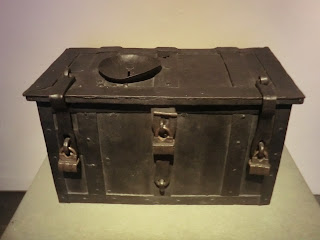
Good morning from Wittenberg!
[The view from our window!]
This ancient town is the place where Martin Luther settled as a monk and began to both study and teach and preach. After a good night's sleep and a wonderful buffet breakfast we set out on a bus for a short ride to the home of Martin Luther his wife, Katherine whose statue greeted us, and nine children.
In the old monastery we saw the pulpit from which Luther preached at the Town Church of which he was pastor.
And here we see what started all the trouble! The Cash Box for the buying of indulgences. Our guide was very knowledgeable about the Reformation and life in the monastery before Luther encouraged all the monks as well as the nuns from a nearby convent to leave.
During this time ordinary people could not read or write. So the stories of the bible were done as paintings to help educate them against the evils of sin. This painting by Kronos has never needed repair or restoration or even cleaning because of his remarkable skill and technique. It teaches the ten Commandments by showing the good people in light colors with angels at their shoulders
and the bad ones in black or yellow with devils grinning!
Katherine made them wealthy. The former nun turned the former monastery into t boarding home for students. She brewed their own beer and grew much of the food she served. Luther was allowed by the King to keep the monastery as the family home after the reformation began even though the King was a devout Catholic and remained so. He admired the learning and teaching ability that Luther had and did not want him as an enemy. Above is the iron stove used for cooking and heating the large stone building. Below is the doorway to Luther's study. It was found accidentally when the interior was being restored. It is in this study where Luther continued to translate the Bible from the original Greek.
I learned a great deal about Martin Luther's history which is, of course, a history that forever changed the world.
After the short ride by bus to the docking point we joined the ship's crew for lunch aboard as we sailed along to Torgau where we would dock overnight. Elva and I enjoyed our lunch from the light buffet served in the lounge so that we could enjoy it in a leisurely manner while watching the world go by - literally!
The afternoon passed quite pleasantly as we got to know our fellow passengers better. The river cruises always seem to draw from many countries and different ages, although usually most are retired. We spent time with Norman and Gerard from Coventry, England. Norman is in his 80's and although quite hard of hearing and slow to move around, he was delightful. His son is with him as Norman's wife died a year ago. Gerard is so much fun to be with and had us frequently in hysterics, especially with the differences of American and British English.
Torgau was a pretty little place of narrow lanes and houses identified by decorative art. It is here at the river that the Russian and American troops met up on April 25, 1945.
The Russians took over an accordion factory. Not a surprise, but that so many knew how to play the difficult instrument was quite a surprise! There was a woman singer who had been imprisoned in the large fortress but the Russians freed her so that she could perform with and for them in an impromptu concert on the square.
After the war the American Battalion presented general Eisenhower with the makeshift flag that they had made to signal the Russians that they were not German and the meet-up was successful and momentous. It was on a bed sheet and they used paints they found at a local store. At first the Russians were suspicious but it was, in the end, the beginning of the end of the War.
Arriving back at the ship, Janos and his crew had prepared Goulash and fresh bread for a festive end to the day steeped in history.
All in all another lovely day of leisurely exploration of two classic German towns.












No comments:
Post a Comment